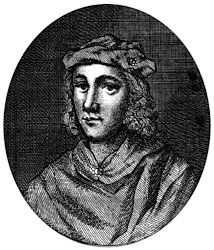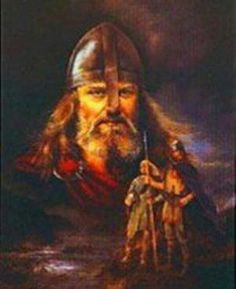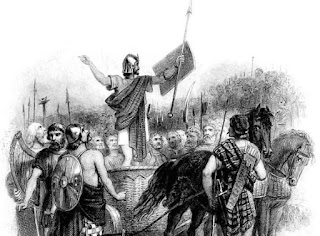Constantine II
The first Gaelic King to rule over the Picts
He is Scotland's Alfred the Great, our forgotten hero king who repelled the Viking invaders, founded the kingdom of Alba, and fought off England's first attempt at conquest.
He is Constantine II, known in Gaelic as Constantin MacAed, one of Scotland's greatest Medieval kings.
He reigned from 900 to 943 and his achievements may even outstrip those of Robert the Bruce. Yet he is little known today, probably because he has never attracted the attention of a great storyteller like Walter Scott or Robert Louis Stevenson.
But Constantine can be seen, in many ways, as the founder of the Scottish nation.
King Constantine II was the grandson of Kenneth MacAlpin, the first Gaelic king to rule over the Picts.
Kenneth died at Forteviot in 858 and his brother Domnall took over the kingship. It was Domnall who introduced Gaelic Law to the Pictish kingdom. Domnall died in 862 and was succeeded by his nephew, Kenneth's son, Constantine.
This Constantine, known as Constantine I, spent most of his reign fighting the Vikings. In his wars he allied himself with Aed Findliath, the king of Ireland, and gave him his sister Mel Muire in marriage.
Constantine I was forced to pay tribute to the Viking leader Olaf the White who had been terrorising Scotland and Ireland since 853. In 874, at a meeting arranged to hand over the tribute, Constantine I ambushed Olaf and slew him.
The king of the Picts was not to enjoy his victory though. The next year the Vikings returned under Halfdan king of York and devastated the Pictish army at Dollar, Clackmannanshire. Within months Constantine I was dead. The second of Kenneth's sons, Aed, then took the kingship of the Picts.
Aed's reign began luckily. The Vikings were fighting amongst themselves and Halfdan was killed by Thorstein the Red at Strangford Lough in Ulster. However, Aed's luck was not to hold.
In 878 he was struck down in Strathallan by his own followers and died of his wounds in the monastery at Rossie, in Perthshire: Within 20 years of Kenneth MacAlpin's death both his sons, Constantine I and Aed, were also dead.
Both men had left sons but these were infants and in those days a child ruler was unacceptable.. Instead Aed's murderer, Giric son of Dungal seized power, claiming at first to be ruling on behalf of a son of one of Kenneth's daughters, Eochaid, but later making himself king
The MacAlpin dynasty in Pictland seemed to be tottering and the Church at Dunkeld, to which Kenneth had moved the relics of Saint Columba, clearly felt nervous.
Within months of Aed's death, Columba's relics were sent to Ireland for safekeeping. It's likely that Aed's young son Constantine, and Domnall, the infant son of his brother Constantine 1, were also sent to Ireland for protection.
We take up the story again eleven years later in 889. Despite early successes, Giric's power had begun to crumble and the grandsons of Kenneth returned to reclaim their kingdom. They hunted Giric down at the fortress of Dundurn, in Strathearn, and made short work of him.
Domnall, the older of the two young men, was recognised as king and reigned for 11 years.
Civil war, however, attracted the attention of the Vikings and Thorstein the Red, whose father Olaf had been killed by Constantine 1, invaded.
The war between Domnall and the Vikings went this and that and Dominall won one-way important victory on the island of Seil in Argyll.
In 893 the balance shifted when Thorstein was joined by his wife's cousin Earl Sigurd the Powerful, and after seven years of warfare they caught up with Domnall on the path below the fortress of Dunnottar and slew him. Yet again the kingdom of the Picts lay at the mercy of Vikings.
Thorstein did not live to enjoy the fruits of victory. He was killed in an uprising in Caithness, and his mother and family fled overseas, eventually settling in Iceland.
In this breathing space Constantine I, was able to secure the kingship for himself. Not much more than a baby when his father, King Aed, had been killed, Constantine had spent most of his life in exile or on the battlefield. In his mid-twenties, he was young for a Garlic king, but he was the only adult left in his family.
No sooner had Constantine II taken control of his kingdom than a new Viking threat emerged. In 902 Flann, king of Ireland had succeeded in driving the Vikings out of Dublin. Under the leadership of Ivar the Younger, the displaced Norsemen made their way to Scotland and attacked Dunkeld, occupying the whole of the Tay basin.
Calling on Saint Columba to avenge the sacking of Dunkeld, Constantine II returned from the North of the country and engaged the Vikings in battle at Strathcarron in 904. Ivar was surrounded and killed, his troops massacred around him. Constantine II, having proven himself in battle, was now able to begin a programme of national reconstruction.
In 906, together with Bishop Cellach, he called a great gathering at Scone and promised to protect the Church and the Faith after the 'manner of the Irish'. The proclamation was made from the moot-hill at Scone where all subsequent kings of Scots were to be enthroned.
It was probably from about this time that the name of the kingdom was changed from the 'Kingdom of the Picts' to 'Alba'.
The civil wars and the Viking invasions had left the kingdom in need of a complete overhaul, and Constantine's long exile in Ireland seems to have reinforced his awareness of his Gaelic heritage. From this time on we rarely hear the name of the Picts again and the name Alba, originally simply Gaelic for 'Britain', symbolises the new way of thinking that marked out Constantine and his successors from those who had gone before.
For the next 12 years, Constantine was able to secure and rebuild his kingdom in relative peace. In 918, however, he answered a call for help from Ealdred of Bamburgh, the Anglian ruler of Northumbria. Ealdred had been driven from his lands by the Viking Ragnall. Constantine led an army south to Corbridge on the Tyne and confronted Ragnall and his army there. The battle was claimed as a victory by both sides.
Constantine's forces beat the main Viking army but were taken in the rear by Ragnall's reserves whom he had concealed in a wood.
At the end of the day the Vikings held the field of battle but Constantine was able to return north leaving Ealdred in control of the lands between the Tyne and the Lothian Esk.
Ealdred's decision to put himself under Constantine's protection marked the beginnings of Scottish - and we can now truly say Scottish rather than Pictish-control in Lothian and the Borders.
Two years after the Battle of Corbridge, together with Ealdred of Bamburgh, Ragnall of York and Owein king of Strathclyde, Constantine met up with Edward the Elder, the King of Wessex who had just conquered the English Midlands.
The meeting probably took place in South Yorkshire and seems to have been arranged so that the changes in borders which had resulted from the recent wars could be agreed and recognised by all the important rulers in Britain.
Seven years later, in 927, following the conquest of York by Edward's son Athelstan, a similar meeting was held, this time further north at Eamont Bridge near Penrith. But Athelstan was not satisfied with simply adding York to his kingdom, which was now almost as big as modern England, and in 934 he invaded Constantine's kingdom of Alba.
The invasion of 934 was one of the largest Scotland had ever faced. As well as all his English followers, the king of Wessex was accompanied by three Welsh kings and six Viking chieftains. The land army was also shadowed by a fleet. Constantine, unprepared for such an onslaught, fled north to his fortress of Dunnottar.
The Scots king must have recalled, nervously, that this was the place where his cousin Domnall had been slain.
This time the fortress proved impregnable and terms were eventually agreed. We do not know what these were but we do know that Constantine spent the following Christmas at Athelstan's court at Buckingham.
Constantine must have felt publicly humiliated by the events of 934, and doubtless many of his subjects began to wonder if he was too old for the job. After all, he was now nearly 60 years of age.
Determined to prove he was not past it, Constantine began to build up a grand alliance. He married his daughter to Olaf, the Viking king of Dublin, and persuaded Owein of Strathclyde that the men of Wessex were not to be trusted and in 937 these three led a huge invasion of England.
Somewhere in the Midlands, they met up with Athelstan's army and a devastating battle was fought at a place called Brunnanburh, the location of which is unknown. Owein of Strathclyde was killed as was Constantine's son Cellach, but on the other side, two of Athelstan's cousins and several earls and bishops were killed. Olaf and Constantine returned home bloody and battered, but Athelstan's dream of creating an English empire collapsed around him and he died two years later, most of his conquests having slipped away.
Constantine had certainly proved that he was not past it and he reigned into his seventies.
In 941 his son-in-law Olaf, who had made himself ruler of York on Athelstan's death, fell out with Oswulf, son and heir to Ealdred of Bamburgh, and invaded Lothian. Olaf was still a pagan and thought nothing of burning down the ancient monastery of Tyninghame. Unfortunately for him, according to legend, the founder of the monastery, St. Baldred, returned from beyond the grave (he had died in 756) and struck him down.
The kings he had feasted and fought with were dead and gone and Constantine, by now a very old man, decided that he had had enough of being a king and retired to become a monk at St Andrews in 943. He lived another nine years and by his death, he had become abbot of the community,
We do not know precisely when Constantine was born, but he died 65 years after his father's death. Very few Dark Age rulers lived to such a great age-Athelstan had been 43 at his death and Olaf may have been in his twenties- and his own survival and resilience in good times and bad made it possible for Alba, the Gaelic kingdom of Scotland, to survive as well.
The man who had become King of the Picts in 900 left the kingdom of the Scots to his heirs.











If you spot any typos, please let me know.
ReplyDelete